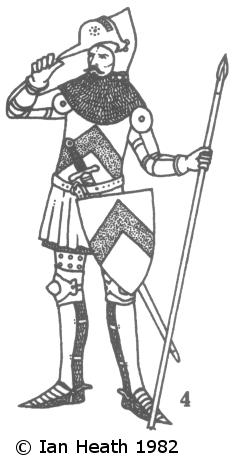
Register a SNAP EBT card with Amazon

RALPH LORD STAFFORD 1347
An extract from Armies of the Middle Ages, Volume 1by Ian Heath


4. RALPH LORD STAFFORD 1347
This figure differs from the last principally in the substitution of complete arm-harness and the addition of greaves and sabatons. His simple leather gauntlets are added from another figure on the same brass, and are unusual in that by this time most gauntlets had at least their cuffs reinforced by scale or splint armour.
The lance, often referred to in contemporary sources by the word glaive, appears at this date to have been about 14 feet in length, of even thickness, and was usually of ash, though Chaucer’s Sir Thopas had a lance of cypress and other woods known to have been used included hornbeam, fir and apple. Contemporary illustrations and writings indicate that the lance was usually painted, often in the lord’s livery colours - for example, an entry in the Beauchamp accounts for 1437 records a lance ‘wreathed in my lord’s colours, red, white and russet.’ The sources also tell us that when men-at-arms dismounted to fight they would cut their lances down to a more manageable length, as they did at Calais in 1349, at Poitiers, at Thorigny in 1359 and at Auray, 5 feet being the specific length mentioned in each case. At Agincourt too the French similarly cut down their lances.
One last detail to note on this figure and the last is the moustache. A beard and moustache were the norm in England from c. 1325 and in France from c. 1340, the beard becoming forked in England from c. 1375. Hair was usually worn long at the sides and short at the front.